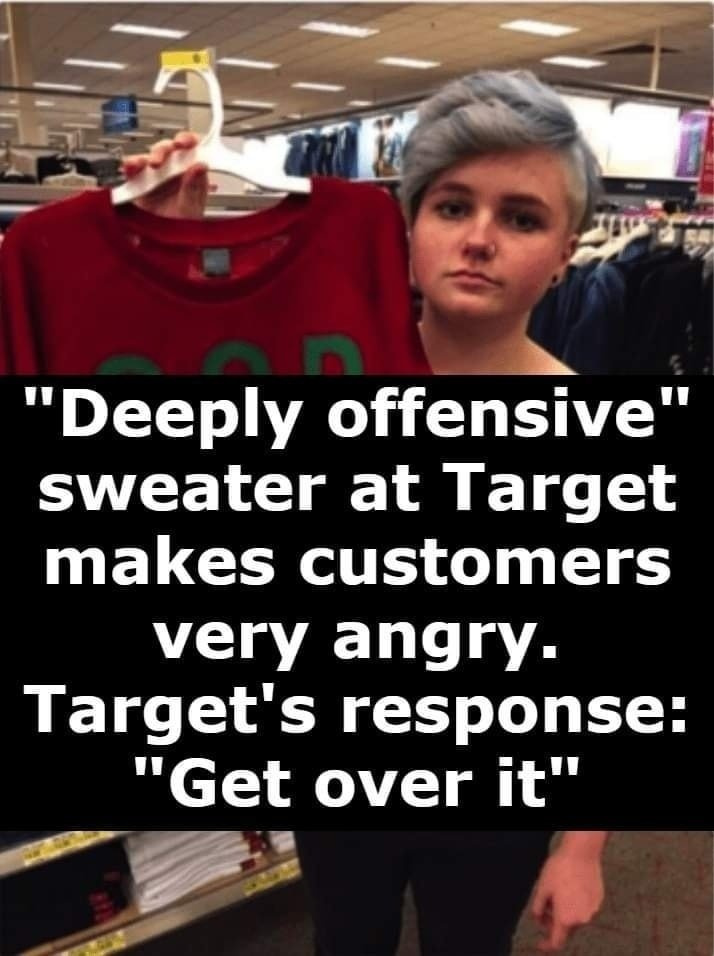A holiday sweater wasn’t meant to spark a nationwide debate, yet that’s exactly what occurred when a Target shopper paused mid-aisle, took a closer look at the design in front of her, and felt a sinking sensation in her stomach. What she had anticipated as a harmless seasonal joke instead struck her as casually dismissive of a genuine mental health struggle. In today’s world — where shoppers are attentive, their voices carry weight, and companies can’t afford to ignore concerns — a single sweater quickly became a topic of discussion about sensitivity, intention, and the evolving expectations for major retailers.
It all started when Reign Murphy, browsing Target’s holiday section, noticed a sweatshirt with bold lettering that read: “OCD Christmas obsessive-compulsive disorder.” At first glance, it seemed intended as a playful twist on being “obsessed” with Christmas. But for Murphy, the message didn’t land that way. Instead, it hit a nerve.
OCD isn’t a quirky habit, a passing fascination, or a seasonal punchline. It’s a serious, often debilitating mental health condition that affects millions of people daily. Intrusive thoughts, compulsions, hours consumed by rituals, strained relationships, disrupted work — none of this has anything to do with holiday enthusiasm. Murphy felt that framing a life-altering disorder as a cute Christmas joke risked trivializing the struggles many face silently.
She expressed her concern publicly, not with anger but with disappointment. She emphasized that companies as influential as Target have a responsibility to consider the messages they distribute, even unintentionally. She wasn’t calling for boycotts or demanding penalties. She simply sought awareness — from designers, marketers, and decision-makers who approve products without always considering how those words might affect someone living with the condition mentioned.
Her post quickly gained attention online.
What surprised many, however, was the diversity of reactions it generated. The internet didn’t erupt with a single wave of condemnation or support. Instead, responses were split — thoughtfully, revealing just how complex these discussions have become.
Many people diagnosed with OCD shared that they personally were not offended. Some even found the sweater lighthearted or harmless. They explained that humor often serves as a coping mechanism, a way to reclaim control from the disorder. They didn’t feel mocked; they simply interpreted it as a joke exaggerating holiday enthusiasm. Others noted that more effort should go into combating stigma around the actual condition, rather than policing casual wordplay.
Still, many echoed Murphy’s concerns, acknowledging that while they weren’t outraged, they understood how the design could mislead others or reinforce the misconception that OCD is merely about being tidy, organized, or “obsessed” with something.
As the conversation grew, Target responded. Spokesperson Jessica Carlson issued a statement acknowledging that some shoppers were uncomfortable and apologizing to anyone hurt by the design. At the same time, she clarified that the sweater would remain available. The company didn’t see harm in the product’s intent and felt it could remain on shelves while still respecting the raised concerns.
It was a measured response, aiming to recognize multiple perspectives without making drastic decisions based on a single opinion. In a way, it reflected the tone of the situation: no frenzy, no moral panic, no widespread outrage demanding removal. There was just a conversation — rooted in the reality that humor is subjective, personal experiences shape perception, and what seems light to one person may be painful to another.
This debate mirrored other public discussions in recent years over clothing featuring phrases like “bride,” “trophy,” “wifey,” or slogans tied to stereotypes about gender roles, marriage, or identity. Some embrace these labels with pride or humor. Others see them as outdated, reductive, or insensitive. Increasingly, every item that reaches store shelves becomes part of broader conversations about representation, identity, and evolving social norms.
What this particular sweater highlighted was how audiences have changed. Modern consumers don’t just purchase; they question. They analyze, consider implications, and discuss openly how products make them feel and what messages companies should promote. Social media transforms individual opinions into collective dialogues that often extend far beyond the moment that sparked them.
Yet this story wasn’t about outrage; it was about awareness.
It reminded people that words carry weight, even on a sweatshirt meant for humor. It highlighted that mental health is deeply personal — not because people want to police language, but because they’ve endured stigma, misunderstanding, and pain that cannot simply be brushed aside.
It also showcased the diversity of human reaction. Even those diagnosed with OCD were split on whether the product offended them. That duality matters. It keeps conversations grounded, preventing them from devolving into simplistic “right or wrong” debates when reality is far more nuanced.
As for Target, the company navigated a middle path: offering an apology without removing the item. It acknowledged concerns while respecting the intent behind the product. In an era when corporations are often criticized for overreacting or staying silent, Target’s approach reflected the mixed public reaction itself.
For Murphy, her message was clear: companies should pay attention. Designers should act intentionally. Humor should be thoughtful. And individuals dealing with real disorders deserve the same consideration afforded to any community facing misunderstanding or oversimplification.
In the days following, shoppers continued discussing the issue — not angrily, but reflectively. They debated intent versus impact, shared personal experiences with mental health, and considered where the line lies between playful and insensitive. In that sense, the sweater achieved what most novelty apparel does not:
It sparked a meaningful conversation.
Not a divisive one. Not a chaotic one. But a human one.
A conversation that prompted reflection, encouraged thought, and illustrated how simple phrases can carry weight. How interpretations vary. How personal experience shapes perception more than any design ever could.
And as long as people continue talking — openly, respectfully, thoughtfully — companies will continue listening.
